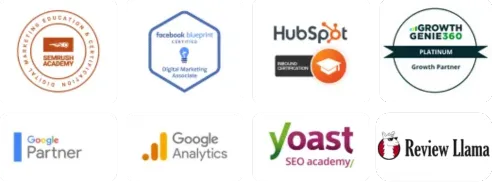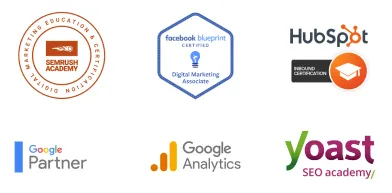TO LEARN IS TO GROW
Learning Center
We do our research and publish our results. Should probably call this the Growing Center.


Things You Must Know About the Website Development Process
The fundamentals of website development and design for business
Today’s new normal requires almost every business to have a website and other digital assets that will allow it to reach its target audience.
Recent studies have shown that about 70 to 80% of consumers use the Internet before buying a product or service. This means that having a website is no longer an option but a necessity in a world that people want fast information.
When creating a website, make sure that its visual elements and overall design reflect its core values (i.e., mission), industry, and target customers.
For a non-professional, web development and design can be an overwhelming process. Hence, you might want to hire a reputable company that can help you boost your digital presence and create an online brand that reflects your company’s mission.
Take note that some web development companies like LOJO also offer digital marketing campaigns that include search engine optimization or SEO, social media management, paid ads (or pay-per-click), and content creation. With a complete web development service, you can enjoy discounts and access talents without having to break the bank (since there is no need to hire and maintain your own IT and digital marketing staff).
What is Website Development?
In a nutshell, website development is building a website from the ground up and making sure that it is accessible to the users. It also consists of different facets: web design, web publishing, web programming, and database management.
Web development also includes client and server-side scripting, server and network security configuration, E-Commerce development, and content management system (CMS) development.
Whether you are creating a simple, plain-text webpage, or a complex web application such as a social networking site, you are developing a website.
Basic Terms Used in Web Development
Website
A website is a publicly accessible collection of files stored on servers, which are computers that host websites. These servers are connected to a global network called the World Wide Web or Internet.
Meanwhile, you can access websites using computer programs known as browsers (e.g., Google Chrome, Mozilla Firefox, Microsoft Edge) that load the data via your internet connection. (Note: The computer that you are using to access websites is called a client.)
IP Address
IP address stands for internet protocol address, a set of rules that determines how data is transmitted over the Internet. It uses a unique string of numbers to access a website.
All websites and devices have an IP address that can be identified from the billions of other sites and devices connected to the Internet.
IP addresses are different from domain names. For example, LOJO Marketing’s website is known as https://lojomarketing.com/, while its IP address is 192.124.249.162.
HTTP
HTTP, which stands for HyperText Transfer Protocol, connects you to the server that contains all the website data. Part of the internet protocol governs how data is transmitted between the server and the client.
HTTP acts as a translator between you and the Internet, making sure that the client and server speak the same “language.”
When you type a website into your browser, it sends a request to the corresponding server, prompting the server to respond with an HTTP status code. If the request is successful, the server will let you access the site.
Here are the common HTTP status codes:
200 – successful request
301 – moved permanently
401 – unauthorized
404 – not found
500 – internal server error
You can learn more about the different HTTP status codes here.
Coding
Coding is the process of writing codes for servers and applications using programming languages. These languages have their vocabulary and grammatical structure; they have special commands, punctuations, and abbreviations.
There are many different programming languages, and each one can be categorized as front-end and back-end.
Front-end
The front-end of a website is everything that the user sees. Front-end coding allows the user to navigate the website, play videos, view images, highlight text, etc. It also allows the website to function seamlessly without having to continuously “communicate” with the Internet.
Back-end
The back-end refers to all parts of the website that the user doesn’t see in simple terms. The back-end is the digital infrastructure, so it is sometimes referred to as the “data access layer.”
For non-developers, it will only look like a bunch of numbers, letters, and symbols that don’t make sense. Almost all programming languages can be used in the back-end.
CMS
A content management system, or CMS, is software used to create, edit, manage, and publish web content. They were originally used to manage local computer files, but now they are designed exclusively for managing web content.
CMS is not always required in website creation, but they come in very handy.
Cybersecurity
Cybersecurity is the practice of protecting internet-connected systems from hackers trying to access users’ private information, steal sensitive data from businesses and customers, or crash servers.
Every website must have protection from cyberattacks and data breaches.
Types of Web Development Professionals
Front-End Development
Front-end development is the building of the client or user-facing side of the website. It focuses on the design and development of the visual aspects of the website.
Front-end development aims to deliver a great user experience by creating an interface that appeals to the users.
Back-end Development
Apart from what you see in the web pages, back-end web developers work on the server-side of the website to make sure that everything is running smoothly. They also handle the communication between the database and the browser.
Back-end development consists of three parts: a server, an application, and a database.

Full Stack Development
A full-stack developer works on both the front and back-ends of a website. These developers can create websites from start to finish, thanks to their “full-service” knowledge.
Full-stack developers can handle projects involving databases, build client-facing websites, and even participate in the planning phase of a project with a client.
Website Creating Process
Now that we have covered all the technical terms let us proceed with the processes involved in creating a website.
Select a website platform. You must decide if you’re going to use a website builder or a CMS to create a website. Both platforms offer all the tools you need to create a professional-looking, functional site.
The benefit of using a website builder is its convenience. You can get everything you need from website building tools, hosting, SSL registration, domain registration, support, etc., in one place. However, it comes with the price of limited flexibility.
On the other hand, CMS provides you complete control over the functionality and aesthetics of your website, allowing you to customize your website.
Choose a hosting plan
Next, you must choose a hosting plan. Web hosting is a service that allows you to run a website on the Internet. Think of it as renting a space on a server that stores your website contents and delivers them to clients who visit your website.
Get a domain name. A domain name is an address that people type into their browsers to visit your website. It’s the one that most people recall about your site.
Most website builders offer a free subdomain for your site, but companies usually pay to have a custom domain name to look more professional.
Choose and customize a theme for your site
Today’s website platforms allow you to choose themes that will dictate the look and feel of your website without coding them. These themes and their templates are mostly customizable, and it’s up to you to make them representative of your business.
As you design your website, you must consider your target audience to help you determine what will work best.
Add web pages to your site
Your web pages will depend on the nature of your business, but it’s always a good idea to have a homepage, “About Us” page, “Products and Services” page, and a “Contact Us” page.
Also, make sure that your web pages are easy to navigate, “interconnected,” and “relevant” based on your business and customer’s needs.
As you design your website, you must consider your target audience to help you determine what will work best.
Create valuable content that appeals to your target consumers
You communicate with your target audience through the content on your web pages, so everything you put in there must reflect your company’s identity and the keywords and phrases your customers are using.
Optimize your website
With Search Engine Optimization or SEO, your website is accessible to your target audience or buyer persona.
A buyer persona is a fictional, detailed description of your target customers based on their online activities, keyword and phrases searches, demographics, likes and hobbies, behavioral traits, etc.
To know more about web development, digital marketing, and SEO campaigns, visit LOJO Marketing.
Built for Growth. Backed by 25 Years of Trust.
For over two decades, LOJO has been a trusted partner to hundreds of businesses just like yours. Whether working directly with owners, managers, teams, or boards of directors, our goal remains the same: to be a reliable and results-driven asset to your business.
Over the years, we’ve carefully built a team of experts—each selected for their unique skills, strengths, and personalities. Our clients choose LOJO because they know we genuinely care about their success.
And after 25 years of helping businesses grow, we’re more committed than ever.


Built for Growth. Backed by 25 Years of Trust.
For over two decades, LOJO has been a trusted partner to hundreds of businesses just like yours. Whether working directly with owners, managers, teams, or boards of directors, our goal remains the same: to be a reliable and results-driven asset to your business.
Over the years, we’ve carefully built a team of experts—each selected for their unique skills, strengths, and personalities. Our clients choose LOJO because they know we genuinely care about their success.
And after 25 years of helping businesses grow, we’re more committed than ever.




Matthew Rogers, President
iProspect Check
After spending several months reviewing multiple proposals from several different companies we engaged LOJO to develop a new website that represents our company effectively. We worked initially with Stephen Platte who helped create the scope of the project. Stephen was knowledgeable and always followed up with me on time and as promised.
He "closed the deal" for LOJO with his professionalism, service orientation and easy going approach. Once we signed the contract we were introduced to Jay Kelly who would be the creative lead for LOJO. This was the most challenging part of the project for my company, as there was no shortage of ideas from our side. Jay managed the project flawlessly, and once we had all agreed to the design, Jay introduced us to Eric.
Eric Lay is one of the founders of LOJO. Eric took the design we had developed and brought it to life. We delivered content as quickly as he requested it. Eric kept the project on task and we responded by exceeding every deadline for content. In turn, once provided, literally not a day went by that Eric didn't add the content and take the next step. In just a few weeks we launched our new website. Eric is a pleasure to work with.
His positive attitude and consultative approach really enhanced the experience and made a big difference for us in the outcome of our project. We would welcome you to visit our website to take a look at the quality work of LOJO. We are very pleased with LOJO and look forward to working with them in the future as we pursue an aggressive SEO strategy."
After spending several months reviewing multiple proposals from several different companies we engaged LOJO to develop a new website that represents our company effectively. We worked initially with Stephen Platte who helped create the scope of the project. Stephen was knowledgeable and always followed up with me on time and as promised.
He "closed the deal" for LOJO with his professionalism, service orientation and easy going approach. Once we signed the contract we were introduced to Jay Kelly who would be the creative lead for LOJO. This was the most challenging part of the project for my company, as there was no shortage of ideas from our side. Jay managed the project flawlessly, and once we had all agreed to the design, Jay introduced us to Eric.
Eric Lay is one of the founders of LOJO. Eric took the design we had developed and brought it to life. We delivered content as quickly as he requested it. Eric kept the project on task and we responded by exceeding every deadline for content. In turn, once provided, literally not a day went by that Eric didn't add the content and take the next step. In just a few weeks we launched our new website. Eric is a pleasure to work with.
His positive attitude and consultative approach really enhanced the experience and made a big difference for us in the outcome of our project. We would welcome you to visit our website to take a look at the quality work of LOJO. We are very pleased with LOJO and look forward to working with them in the future as we pursue an aggressive SEO strategy."

Matthew Rogers, President
iProspect Check
The team at LOJO were wonderful to work with. They are well organized and very patient as we worked through our marketing strategy and developed a well thought out and clear action plan at a reasonable price. We will definitely be back for our future campaign needs."

Jon Crosby, Founder
Dazil

